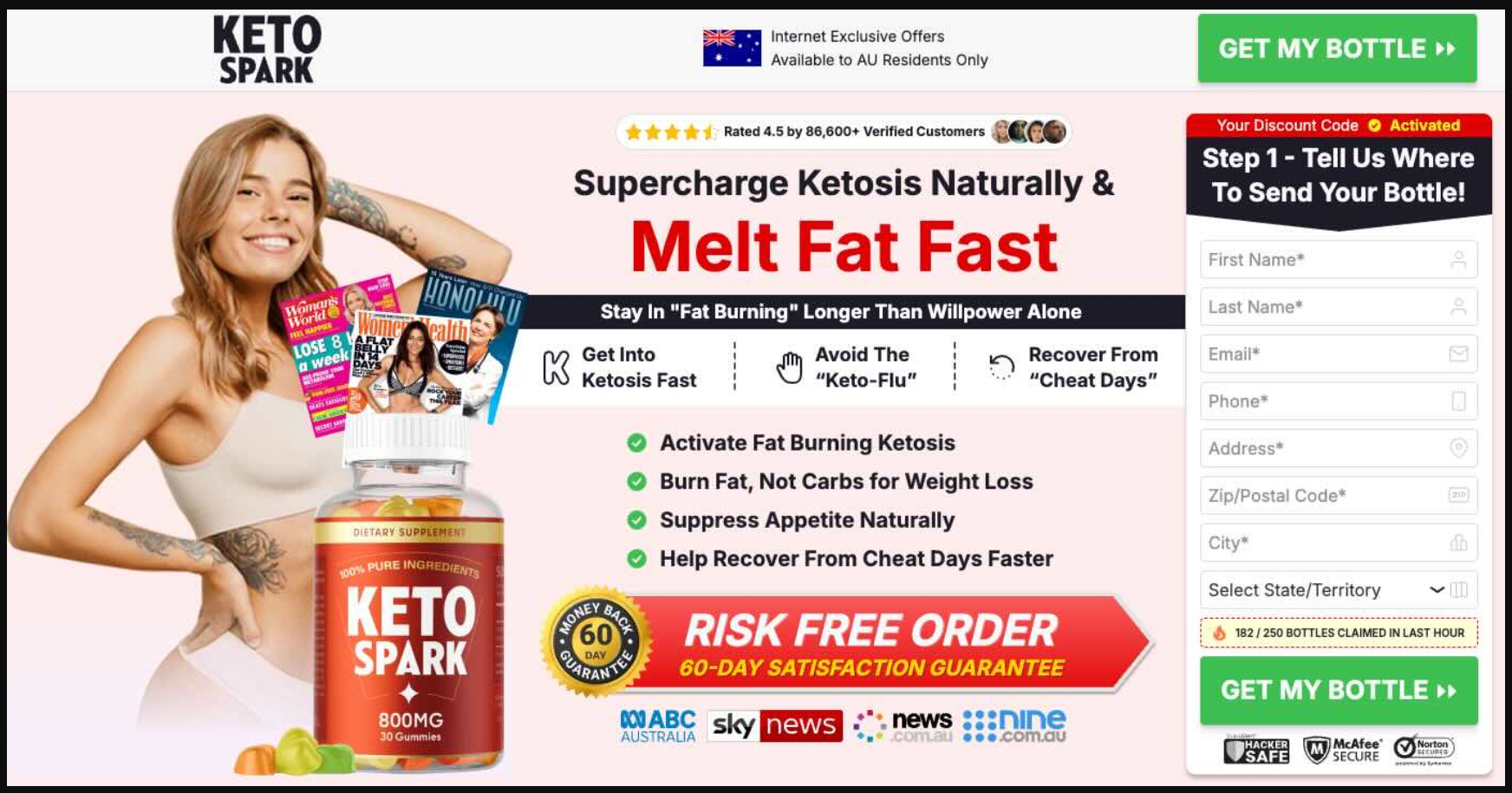
Losing weight is not easy. People will tell you to eat less and work out more. This advice, as sound as it is, rarely works on most people. What makes the weight loss journey worse is the blatant lies of the weight loss industry. They push fad diets and herbal supplements that rarely work. Finding the one product that can boost weight loss results is difficult. We did the research and found one particular supplement that can supercharge your weight loss journey. It is Keto Spark Gummies.
As the name suggests, these gummies are going to activate ketosis. Ketosis is the metabolic state in which the body burns fat for energy. So, you lose weight and gain energy. In this Keto Spark Gummies review, you will get all the necessary information about the ingredients, benefits, working, potential risks, and why these gummies are so popular in Australia.
What are Keto Spark Gummies?
Keto Spark Gummies Australia are a dietary supplement in the form of gummies designed to help you lose weight. They claim to activate ketosis with the help of plant-based ingredients. It can supercharge your metabolism. Moreover, it can suppress appetite.
What makes these gummies stand out is the reduced risk of side effects. Most weight loss supplements make you feel weak; Keto Spark Gummies, on the other hand, boost energy levels. Few users have reported increased stamina and improved mental clarity.
Product Information
- Product Name: Keto Spark Gummies Australia
- Brand name/ Manufacturers: O. Labs
- Product weight: 5 grams
- Supplement Type: Gummies
- Taste: Sweet (Artificial Sweetener)
- Colour: Multicolour
- Age Group: Adults (21 and above)
- Gender: Unisex
- Count Per Bottle: 30
- Money Back Guarantee: 30 Days
- Contact Information: contact@Ketospark-au.com
- Dosage: 1 gummy a day after breakfast
Who would benefit the most from Keto Spark Gummies?
- People who are trying to lose weight
- People who want to boost metabolism
- People looking to improve energy levels
- People who have hit a plateau in their weight loss journey
- People looking for a natural alternative to weight loss supplements
Top 7 Benefits of using Keto Spark Gummies for weight loss
- Weight loss: The primary goal of these weight loss gummies is to help lose weight. And they are very good at it. These gummies will burn the most stubborn fat.
- Improved Metabolism: An improvement of 5% in metabolism can help you lose 7% of your body weight in three months. So, expect these gummies to boost your Basal Metabolic rate.
- Boosted Energy levels: Keto gummies work by burning fat for energy instead of relying on the carbs in the diet. During ketosis, you gain energy, stay active, and alert all day.
- Reduced Risk of Cardiovascular Complications: Obesity is the second leading cause of death in the USA. It affects heart health as well. By losing weight, you reduce the fat accumulation in arteries and reduce the risk of blockage.
- Body Confidence: When you lose weight, you gain the confidence to put yourself out in public with no shame or guilt. You will feel energetic and happy.
- Improved Mobility: Extra weight can make it difficult to move around. The stress on joints can cause pain. By losing weight, you can reduce stress.
- Reduced Side Effects: Makes it a near-perfect weight loss supplement.
Key ingredients in Keto Spark Gummies Australia
- BHB (Beta-Hydroxybutyrate Salts): This key ingredient will assist in activating the ketosis. Ketone salts are naturally produced in our bodies. The natural production is very low. Not enough to trigger ketosis. By supplying the exogenous ketones, we can push our body into ketosis.
- Apple Cider Vinegar: These gummies used the ACV concentrate. It is a known metabolism booster. Many studies have proven the benefit of drinking apple cider vinegar in the morning for weight loss.
- MCT-Oil (Medium-chain Triglycerides): A potent weight loss ingredient. MCT can convert fat into ketones. This conversion takes place in the liver. It speeds up the fat-burning process.
- Soluble Fiber: The Primary reason for adding fiber is to make you feel full. Our body cannot digest fiber. So, they are in the stomach for a longer period. And they can absorb water, making you feel full.
- Green Coffee Extract: Another metabolism booster ingredient. Helps burn extra calories.
How does it work?
Keto Spark Gummies try to mimic the keto diet. The keto diet is where you drastically reduce the carbs in your diet and replace them with protein and healthy fats. This results in pushing our body into ketosis. During ketosis, fat is turned into ketones, and ketones are used as the source of energy. The result is that you burn all the fat and gain energy.
Along with ketosis, Keto Spark Gummies boost metabolism. As per the 2002 study, people with high metabolism do not gain extra weight. High metabolism results in extra calorie expenditure.
Along with burning fat, you eat less. The appetite-suppressing ingredient in this weight loss gummy helps reduce snacking between meals. It makes you feel full for longer. Thus, reducing the extra calorie intake.
So, you are burning fat and eating less. This is the essence of weight loss.
Scientific Evidence to support Keto Spark Gummies
A 2023 study published in the Journal of Nutritional Science and Vitaminology shows a positive correlation between BHB salt and the burning process.
Another study published in Frontiers in Nutrition (2021) proves that regular intake of apple cider vinegar can improve metabolism in a few people.
A BMJ Nutrition, Prevention & Health study shows a positive correlation between green coffee beans and metabolism.
Customer Reviews on Keto Spark Gummies after 4 weeks of use
Sheila, 45, Sydney, “I am surprised by the results. Keto Spark Gummies helped me lose almost 10 pounds in 12 weeks.”
Laura, 50, Brisbane, “I tried more than 4 weight loss supplements, Keto Spark Gummies, is my fifth, I am glad it worked for me. Definitely recommended.”
Riley, 29, Queensland, “I struggled with my entire teenage years. Dieting and working out are hard, but with Keto Spark Gummies Australia, it is easier to lose weight.”
Monica, 37, Brisbane, “I am not sure about the product yet. Been using it for almost three weeks, yet to see results.”
Pros and cons of Keto Spark Gummies
Pros:
- Non GMO
- Stimulant free
- Gluten free
- Sugar Free
Cons
- Internet Exclusive
- Not for people under 18
- Lack of third-party testing data
Are there any Keto Spark Gummies side effects that you should be aware of?
- Digestive issues like bloating and gas
- Electrolyte imbalance if you drink less water
- Headache and nausea
- Allergic reaction in rare cases
Conclusion
The weight loss process can be psychologically and physiologically taxing. Instead of falling for the fat diets and fake supplements, try Keto Spark Gummies. These keto gummies contain herbal ingredients, and they activate ketosis, boost metabolism, and suppress appetite. This supplement can assist with healthy weight loss goals. It is especially popular in Australia. Buy it from its official website only.
Frequently Asked Questions
What is the opinion of Keto Spark Gummies Reddit users?
Reddit users have mixed opinions on these gummies. Some are happy while others find it useless.
Do Keto Spark Gummies actually work?
Yes, there are people who have used Keto Spark Gummies and managed to lose weight. So, yes, it works for some people.
Is it okay to take keto gummies for a long time?
These gummies have nothing that can have long-term effects. However, we recommend consulting a doctor before making any decision.
Can keto gummies reduce the risk of “Keto-Flu”?
Data on this issue is not clear. More research is needed to make a conclusive decision.

Disclaimer & Copyright
The content on AmericanPainSociety.org is provided for general informational purposes only and should not replace professional medical advice, diagnosis, or treatment. We make no guarantees of accuracy, completeness, or timeliness. Users rely on the information at their own risk. Always consult qualified professionals for healthcare decisions.
© 2025 American Pain Society. All rights reserved. No part of this website may be reproduced, distributed, or transmitted in any form or by any means without prior written permission.
